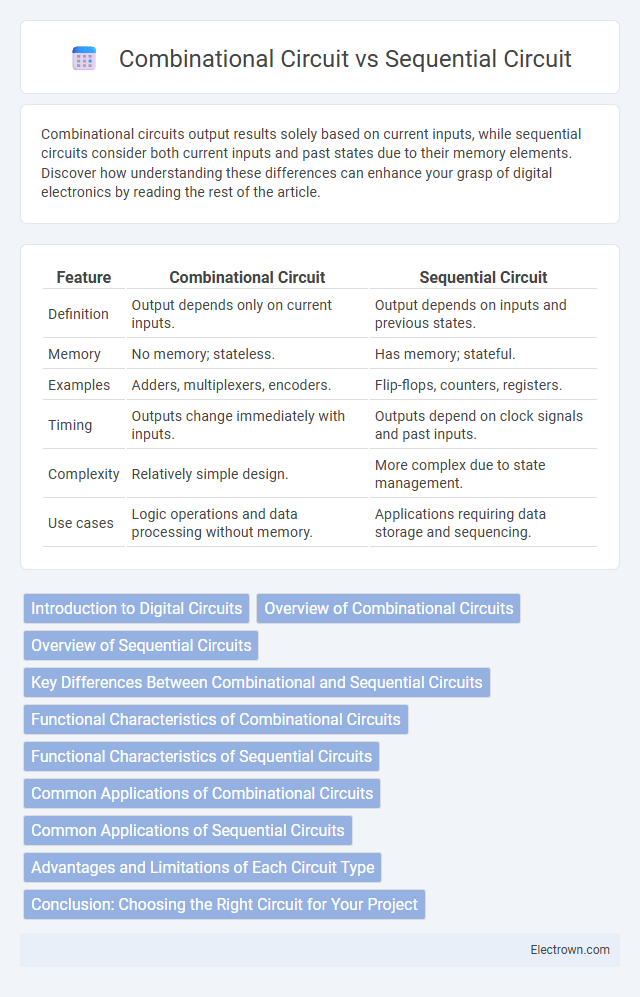Combinational circuits output results solely based on current inputs, while sequential circuits consider both current inputs and past states due to their memory elements. Discover how understanding these differences can enhance your grasp of digital electronics by reading the rest of the article.
Table of Comparison
| Feature | Combinational Circuit | Sequential Circuit |
|---|---|---|
| Definition | Output depends only on current inputs. | Output depends on inputs and previous states. |
| Memory | No memory; stateless. | Has memory; stateful. |
| Examples | Adders, multiplexers, encoders. | Flip-flops, counters, registers. |
| Timing | Outputs change immediately with inputs. | Outputs depend on clock signals and past inputs. |
| Complexity | Relatively simple design. | More complex due to state management. |
| Use cases | Logic operations and data processing without memory. | Applications requiring data storage and sequencing. |
Introduction to Digital Circuits
Combinational circuits in digital systems produce outputs solely based on current input values, without memory elements, enabling straightforward logic operations like addition and multiplexing. Sequential circuits rely on both current inputs and past states, utilizing memory elements such as flip-flops to manage timing and data storage, crucial for applications like counters and registers. Understanding the distinction between combinational and sequential circuits forms the foundation for analyzing and designing complex digital devices.
Overview of Combinational Circuits
Combinational circuits produce outputs solely based on the current inputs without relying on past data, enabling immediate response in digital systems. They are composed of logic gates such as AND, OR, and NOT, and include devices like multiplexers, adders, and encoders essential for arithmetic and decision-making operations. These circuits are foundational in digital hardware design, providing predictable and stateless functionality critical for fast computation and signal processing.
Overview of Sequential Circuits
Sequential circuits store and utilize past input information through memory elements, enabling them to exhibit time-dependent behavior unlike combinational circuits. They consist of flip-flops and latches that maintain states, allowing outputs to depend on both current inputs and previous states. Sequential circuits are essential in designing memory modules, counters, and state machines where timing and state retention are critical.
Key Differences Between Combinational and Sequential Circuits
Combinational circuits generate outputs solely based on current input values without involving memory elements, making their response time dependent on gate delays. Sequential circuits incorporate memory elements such as flip-flops or latches, enabling outputs to depend on both current inputs and previous states, which allows storage of information and complex behaviors. The primary distinction lies in the presence of feedback loops and timing dependency, with sequential circuits requiring clock signals for state transitions, unlike combinational circuits that operate purely on combinational logic.
Functional Characteristics of Combinational Circuits
Combinational circuits produce outputs solely based on the current inputs without any memory element, ensuring immediate output response to input changes. These circuits perform basic logical functions such as addition, subtraction, and multiplexing, relying entirely on gate-level operations. Unlike sequential circuits, combinational circuits have no feedback loops, making their behavior predictable and free from timing dependencies.
Functional Characteristics of Sequential Circuits
Sequential circuits store information using memory elements, enabling output to depend on both current inputs and past states. They exhibit feedback loops, which create state retention and temporal behavior essential for tasks like counting and state machines. The presence of clock signals synchronizes state transitions, distinguishing sequential circuits from combinational circuits that produce outputs solely based on current inputs without memory.
Common Applications of Combinational Circuits
Combinational circuits are widely used in arithmetic logic units, multiplexers, and encoders, providing fast and predictable outputs based solely on current inputs. These circuits play a critical role in digital systems such as calculators, digital clocks, and data routing devices where immediate computation without memory is essential. Their simplicity and speed make them ideal for tasks like binary adders, subtractors, and code converters.
Common Applications of Sequential Circuits
Sequential circuits are widely used in applications requiring memory and state retention such as digital clocks, counters, and shift registers. They play a critical role in finite state machines, which are fundamental in designing control units for processors and communication protocols. Common examples also include flip-flops for data storage, registers for temporary data holding, and memory elements in embedded systems.
Advantages and Limitations of Each Circuit Type
Combinational circuits offer advantages such as simplicity, faster operation due to the absence of memory elements, and predictable output based solely on current inputs, making them ideal for arithmetic and logic operations. Their limitation lies in the inability to store past input information, resulting in no memory and inability to handle sequential data or time-dependent processes. Sequential circuits, integrating memory elements like flip-flops, provide the advantage of storing previous states for complex operations such as counters and state machines but suffer from increased design complexity and slower speed due to clock dependency and feedback paths.
Conclusion: Choosing the Right Circuit for Your Project
Choosing the right circuit for your project depends on whether you need memory or state retention; combinational circuits perform logic functions based solely on current inputs, making them ideal for simple, stateless tasks. Sequential circuits incorporate memory elements, allowing them to handle time-dependent operations and store past states, which is essential for complex applications like counters, registers, and state machines. Understanding these differences ensures you select a circuit that optimally balances complexity, speed, and functionality for your specific design requirements.
Combinational Circuit vs Sequential Circuit Infographic

 electrown.com
electrown.com